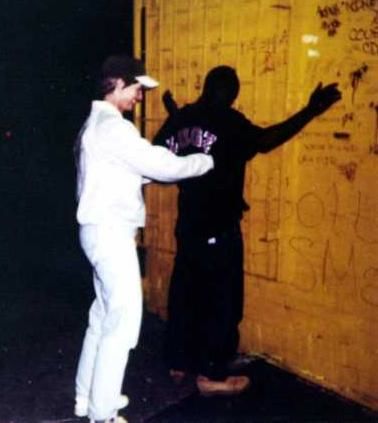Clueless Conservationists with Cognitive Dissonance
In psychology, cognitive dissonance is the mental stress or discomfort experienced by an individual who holds two or more contradictory beliefs, ideas, or values at the same time, or is confronted by new information that conflicts with existing beliefs, ideas, or values. ~~~ Wiki

Queen of NJ Open Space, then Gov. Christie Whitman does a stop & frisk of a black man with State Police in Camden. The all white outfit and the smile on her face says everything.
The open space debate is occurring within a much broader debate in America about class and race, a long simmering but suppressed debate that was long overdue, particularly in the elite and overwhelmingly white conservation community.
Just like the Occupy Wall Street Movement opened the door and created space to talk about deep inequality in America and how the wealthy 1% were greedily using their power to accumulate even more wealth to the detriment of the 99%, the current protests and rebellions growing out of police murders of unarmed black men and children in Ferguson, Cleveland , and NY City have brought issues of race to the forefront.
So, from now going forward, just like OWS generated focus on how public policy addressed wealth & income inequality, the door is now open to drill down on how race and environmental justice are addressed (or ignored) in various conservation and environmental policy debates.
So, through that lens, at a time when these issues are emerging, and conservationists are being criticized for their neglect of urban, class, and environmental justice issues, I was taken aback by the sheer cluelessness and insensitivity of an NJCF piece on saving wood turtles.
The piece, titled: How did the turtle cross the road? In a tunnel begins thusly:
Several years ago, Bedminster Township in Somerset County built bridges and pathways to help pedestrians and bicyclists safely cross some of its busiest roads, including Routes 206 and 287. Now it’s doing the same for another group of residents … reptiles and amphibians.
Bedminster Township in one of NJ’s wealthiest and whitest.
It’s nice that they can afford to protect their pedestrians and cyclists and it warms my heart to know that Bedminster residents and their conservationist and Foundation friends care so deeply about reptiles and amphibians (but not apparently enough to stop massive corporate office park and housing developments and highways that are destroying their habitat, or to oppose the DEP’s elimination of protections for wood turtle habitat).
But the pedestrian and turtle protections in Bedmister got me to thinking about why people have less protections in the rest of the state.
The most recent NJ State Police data on pedestrian fatalities shows 144 pedestrians were killed so far this year, only 4 in Somerset county, one of the lowest in the state (Morris had 0 and Hunterdon just 1, while Camden had 17 and Essex 13, among the highest.)
According to a Report by Tri-State Transportation Campaign,
Conclusions
Pedestrians often face significant danger walking along and crossing roads in southern New Jersey. These pedestrians have been killed at a higher rate than the nation as a whole. National data indicates that Hispanics/Latinos and African-Americans have a higher pedestrian fatality rate than non-Hispanic whites. However, there is no way of substantiating these nationwide statistics locally, because race/ethnicity data is not uniformly collected at the local level. This report shows significant gaps in the reporting of race/ethnicity for southern New Jersey pedestrians killed between 2007 and 2009.
NJCF further described the turtle crossing project:
Decades ago, Bedminster officials resolved to make the town friendlier for walkers and bicyclists by building a “hike and bike” path connecting The Hills townhouse complex and shopping centers in its southeast corner with the elementary school, library and parks to the north. Creating the trail took some serious engineering, including pedestrian bridges over highways and on-off ramps. State funding paid for much of the work.
The contradictions and fairness issues are obvious.
Is NJCF clueless and insensitive? Are they rubbing salt in the wound?
Does NJCF ever ask whether poor black and Hispanic kids in our urban areas enjoy safe sidewalks, bridges, and bike paths from home, to schools and shopping centers?
So, once again we see State funding not based on need.
We see residents of wealthy communities benefitting, in this case, even the resident turtles, while other poor and minority communities in need are ignored.
And we see mitigation band aids applied while regulatory tools are ignored by conservationists, as they divert public funds from the DEP they praise.
Contradictions, leading to cognitive dissonance.